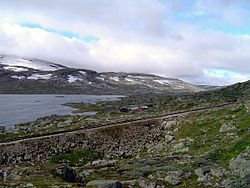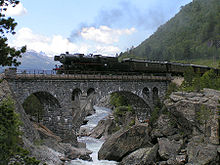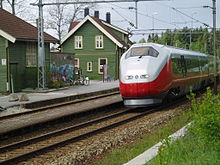- Rail transport in Norway
-
Norway 
Bergensbanen at Finse, the highest point of the Norwegian railways. Operation National railway Norges Statsbaner Infrastructure company Jernbaneverket Statistics Ridership 54 million Passenger km 2,717 million Freight 25 million tonnes System length Total 4,087 kilometres (2,540 mi) Double track 242 kilometres (150 mi) Electrified 2,622 kilometres (1,629 mi) High-speed 64 kilometres (40 mi) Gauge Main 1,435 mm (4 ft 8 1⁄2 in) Electrification Main 15 kV 16⅔ Hz AC Features No. tunnels 696 Longest tunnel Romeriksporten No. bridges 2,760 Longest bridge Strømsløpet Bridge Highest elevation 1,237 metres (4,058 ft) at Finse  A Class 63 steam engine
A Class 63 steam engine
 The completion of Bergensbanen
The completion of Bergensbanen
The Norwegian railway system comprises 4,087 km of 1,435 mm (4 ft 8 1⁄2 in) (standard gauge) track of which 2,622 km is electrified and 242 km double track. There are 696 tunnels and 2760 bridges.
Jernbaneverket is a state owned agency which builds and maintains all railway tracks, while other companies operate them. These companies include Norges Statsbaner, NSB Anbud, CargoNet, Flytoget, Hector Rail, Tågåkeriet and Ofotbanen.
Norway is a member of the International Union of Railways (UIC). The UIC Country Code for Norway is 76.
Contents
History
Main article: History of rail transport in NorwayThe first railway in Norway was Hovedbanen between Oslo and Eidsvoll and opened in 1854. The main purpose of the railway was to freight lumber from Mjøsa to the capital, but also passenger traffic was offered. In the period between the 1860s and the 1880s Norway saw a boom of smaller railways being built, including isolated railways in Central and Western Norway. The predominant gauge at the time was 1,067 mm (3 ft 6 in) (narrow gauge) , but some lines were built in 1,435 mm (4 ft 8 1⁄2 in) (standard gauge). The height of the era came in 1877 when Rørosbanen connected Central Norway to the capital. In 1883 the entire main railway network was taken over by NSB, though a number of industrial railways and branch lines continued to be operated by private companies.
Three urban railways, in Oslo, Bergen and Trondheim, were started as horsecar systems between 1875 and 1893. They were all electrified around the turn of the century.
The second construction boom of the main railway arose in the 1910s and included the Bergensbane across Finse to Bergen, connecting Eastern and Western Norway. Also a number of other larger projects were built through the 1920s, including a second line, Dovrebanen, to Trondheim. This period also saw the first electrified railways and a steady conversion from narrow gauge to standard gauge. Norway chose to electrify their network at 15 kV 16⅔ Hz AC.
During World War II there was a massive construction by the German Forces as part of creating Festung Norwegen, including large sections of Nordlandsbanen and the completion of Sørlandsbanen. After the war the main effort was to complete Nordlandsbanen (that reached Bodø in 1962) and completing the decision to electrify 50% of the network, a task not completed until 1970. This allowed the retirement of the steam locomotive, being replaced with electric engines like the El 11 and El 13 or the diesel powered Di 3. In 1966 Norway's only rapid transit, Oslo T-bane was opened, but in the same decade the Bergen tramway was closed. In the 1970s and 80s a lot of branch lines were also abandoned.
In 1980 the massive project of connecting the eastern and western railway networks around Oslo was completed with the opening of the Oslo Tunnel and Oslo Central Station. In 1996 NSB was split in the Norwegian Railway Inspectorate, Jernbaneverket and operating company NSB BA. Since the companies have been split into 10 separate companies and corporations. In 1998 the first new line in 36 years was opened when the high-speed railway Gardermobanen was opened to allow travel at 210 km/h between Oslo, Oslo Airport and Eidsvoll. The 1990s also saw the massive introduction of multiple units on passenger trains. In the 2000s the freight segment was deregulated and a number of freight companies have started competing with the NSB partial subsidiary CargoNet.
Network
Track
The main railway network consists of 4087 km of lines, of which 242 km is double track and 60 km high-speed rail (210 km/h). In addition there is 225 km of urban railways, of which 218 km is double track. In addition there are some industrial tracks and minor branch lines and some abandoned and heritage railways. The entire main network is 1,435 mm (4 ft 8 1⁄2 in) (standard gauge), as are the urban railways in Oslo and Bergen. Of the operational railways in Norway, only the Trondheim Tramway has a different gauge, the meter gauge, 1,000 mm (3 ft 3 3⁄8 in). Some heritage railways, though, operate with various kinds of narrow gauge.
Kirkenes-Bjørnevatnbanen used to be the northernmost railway in the world; however, it was closed down in 1997, but shall open again in 2009. Still, Narvik is one of the northernmost towns in the world to have a railway connection, as the terminus for Ofotbanen. It connects to Kiruna, Sweden, but not to Bodø, the northern terminus of the Norwegian railway network. Kiruna is, however, connected to the Swedish railway network, which again is connected to the Norwegian network at the Swedish station of Charlottenberg, Storlien and Kornsjø.
Traction
2622 km (64%) of the railway network is electrified, all of it at 15 kV 16⅔ Hz AC with overhead wires. The only sections that are not electrified are the lines north of Mjøsa, with the sole exception of Dovrebanen and the Ofotbanen. On non-electrified sections diesel locomotives are used. All of the urban railways use 750 V DC, via overhead wires on the tramways and via third-rail on the Oslo T-bane.
Future expansion plans
In its plans, Jernbaneverket will concentrate its expansions primarily on the cramped network around Oslo and the larger cities.
- Oslo-Ski: New doubletrack in new corridor for intercity and freight trains finished in 2018. Existing doubletrack is used for local trains.
- Skøyen-Asker: New doubletrack in new corridor for intercity and freight trains. Existing doubletrack is used for local trains.
- Vestfoldbanen: Before 2019: 17km doubletrack connected to existing doubletrack from Drammen, and 5,5km doubletrack north of Tønsberg. Between Larvik and Porsgrunn ca 25km of new doubletrack will cut 22 minutes of travel time. The plan is to make the whole line doubletrack after 2019.
- Sørlandsbanen: Double track from Stavanger to Sandnes will be ready in 2009. Later plans may include a new line through Drangsdalen, and connect Sørlandsbanen to Vestfoldbanen between Porsgrunn and Skorstøl.
- Østfoldbanen: before 2019: Østfoldbanen is today double track both north and south of Moss, but in Moss 10km remains as a single track bottleneck. Plans is to build a tunnel under the city. After 2019 plans is to build double track further south to Halden/Kornsjø.
- Ringeriksbanen is a planned railway between Sandvika and Hønefoss that will reduce travel time between Oslo and Hønefoss/Bergen by 50 minutes.
- Bergensbanen: Double track from Bergen to Arna.
- Dovrebanen: Before 2019: Expanding to double track from Eidsvoll and 3 km north, and on the 33km between Minnesund and Sørli. After 2019 plans is to build double track of the rest of the part between Eidsvoll and Hamar, and maybe further to Lillehammer.
- Nordlandsbanen/Meråkerbanen: New tunnel through Gevingåsen and new bridge south of Stjørdal. Possibly electrifying of Meråkerbanen and Nordlandsbanen up to Steinkjær.
The Bergen Light Rail will open in 2010 while there is discussion as to whether an automated rapid transit from Lysaker to Fornebu outside Oslo should be built. Also the Oslo T-bane will be expanded.
Main article: High-speed rail in NorwayThe question about building a high-speed railway between the largest Southern Norwegian cities has been discussed at political level, and a report was ready by the end of 2007. Advocates for rail transport and environmentalists have wanted to build high speed railways, including upgrades to 250 km/h on Sørlandsbanen, Bergensbanen and Dovrebanen while others, including Norsk Bane, have suggested construction of a new line through Haukeli to Stavanger, Haugesund and Bergen.
Heritage
There are also several operational museum railways in Norway, including Krøderbanen, Setesdalsbanen, Aurskog-Hølandsbanen, Thamshavnbanen, Rjukanbanen, Valdresbanen, Nesttun-Osbanen and Gamle Vossebanen. The Norwegian Railway Museum is located in Hamar and includes exhibits of train hardware, related objects, as well as document and photography archives.
Railway links with adjacent countries
 Sweden - yes - same gauge - same voltage (three electric lines and one non-electric)
Sweden - yes - same gauge - same voltage (three electric lines and one non-electric) Denmark - yes - same gauge - through Sweden
Denmark - yes - same gauge - through Sweden Germany - yes - same gauge - through Sweden and Denmark
Germany - yes - same gauge - through Sweden and Denmark Finland - yes - through Sweden, break-of-gauge 1,435 mm (4 ft 8 1⁄2 in)/1,524 mm (5 ft) at the Swedish/Finnish border
Finland - yes - through Sweden, break-of-gauge 1,435 mm (4 ft 8 1⁄2 in)/1,524 mm (5 ft) at the Swedish/Finnish border Russia - yes - through Sweden and Finland
Russia - yes - through Sweden and Finland
Operation
Railway companies
Traditionally, all trains were operated by NSB, but the deregulation in the 2000s has led to the introduction of a number of new freight operators, including CargoNet, Hector Rail, Tågåkeriet and Ofotbanen. The conservative-liberal government tried to introduce public service obligation bids on subsidized passenger routes in 2005, but the contract was won by the NSB subsidiary NSB Anbud and the following red-green government has cancelled further PSO contracting. Also the Airport Express Train has been made a separate company.
Passenger rolling stock
Until the 1990s only commuter and regional trains were operated with multiple units, but since then NSB has ordered numerous multiple units for its regional and express lines. Express trains are operated with 16 BM 73 units with tilting technology, regional trains with 16 BM 70, 6 BM 73b (both electric) and 15 BM 93 (diesel) units while the local trains are operated by 71 BM 69 and 36 BM 72 (both electric) while the local trains around Trondheim, Trønderbanen, uses 14 BM 92 diesel multiple unit. The Airport Express Train uses 16 BM 71 and NSB Anbud operates 9 BM 69g units. Ofotbanen operates three BM 68 electric multiple units.
NSB still uses locomotive hauled passenger trains on a few of the long distance lines. For this task they use 22 El 18s and 5 Di 4s in addition to six El 17 on Flåmsbana. Most of the cars are B7 on long distance services and B5 on regional services. Most of the locomotives have been transferred to the freight division CargoNet.
Freight rolling stock
CargoNet uses a combination of 30 El 14, 15 El 16, 19 Di 8 and 6 CD66. The other companies use stock retired by NSB, including Ofotbanen's 7 El 13, 5 Di 3 and 2 T43, HectorRail's 6 El 15 (now known as 161) and Tåkåkeriet's Rc2.
Norwegian railway network
Fully operational lines
Line name Termini Length Power Opened Other info Bergensbanen Hønefoss Bergen 371 km Electric 01.12.1909 Operated route Oslo S–Drammen-Bergen (495 km) Flåmsbana Myrdal Flåm 20 km Electric 15.10.1941 Branch to Bergensbanen Randsfjordbanen Hokksund Hønefoss 54 km Electric 13.10.1868 Operated as part of Bergensbanen Bratsbergbanen Eidanger Nordagutu 47 km Electric 17.12.1917 Operated route Porsgrunn-Notodden (incl. Tinnosbanen)
Eidanger–Skien operated as part of VestfoldbanenTinnosbanen Hjuksebø Notodden 10 km Electric 09.08.1909 Operated route Porsgrunn-Notodden as part of Bratsbergbanen Dovrebanen Eidsvoll Trondheim 492 km Electric 20.09.1921 Operated route Oslo S–Dombås-Trondheim (553 km) Raumabanen Dombås Åndalsnes 115 km Diesel 30.11.1924 Operated as branch to Dovrebanen Drammenbanen Oslo S Drammen 42 km Electric 07.10.1872 Askerbanen Sandvika Asker 15 km Electric 01.08.2005 Parallel line to Drammenbanen Spikkestadbanen Asker Spikkestad 12 km Electric (07.10.1872)
03.06.1973Branch to and originally part of Drammenbanen
Operated route Spikkestad-Oslo S-MossGardermobanen Etterstad Eidsvoll 64 km Electric 22.08.1999 Operated route Oslo S-Lillestrøm-Gardermoen/-Eidsvoll Gjøvikbanen Oslo S Gjøvik 123 km Electric 28.11.1902 Hovedbanen Oslo S Eidsvoll 84 km Electric 01.09.1854 Kongsvingerbanen Lillestrøm Charlottenberg 116 km Electric 04.11.1865 Operated route Oslo S-Lillestrøm-Kongsvinger/-Sweden
Continues as VärmlandsbananMeråkerbanen Hell Storlien 70 km Diesel 17.10.1881 Operated route Trondheim-Hell-Meråker-Sweden
Continues as MittbananNordlandsbanen Trondheim Bodø 734 km Diesel 01.02.1962 Ofotbanen Narvik Bjørnfjell 43 km Electric 15.11.1902 Continues as Malmbanan Rørosbanen Hamar Støren 382 km Diesel 17.10.1877 Operated route Oslo S-Hamar-Røros-Trondheim Sørlandsbanen Drammen Stavanger 549 km Electric 01.03.1944 Operated route Oslo S-Kristiansand-Stavanger (588 km) Arendalsbanen Arendal Nelaug 36 km Electric (18.12.1910)
22.06.1938Branch to Sørlandsbanen
Originally part of TreungenbanenVestfoldbanen Drammen Eidanger 138 km Electric 24.11.1882 Operated route (Lillehammer-)Oslo S-Skien Østfoldbanen Oslo S Kornsjø 171 km Electric 25.07.1879 Operated route Oslo S-Halden/-Sweden
Continues as Norge/VänernbananØstfoldbanen, Eastern line Ski Rakkestad 54 km Electric 24.11.1882 Operated route Oslo S-Rakkestad Freight only lines
Line name Termini Length Power Opened Other info Alnabru-Grefsenlinjen Grefsen Alnabru 2 km Electric 20.01.1901 Connecting Hovedbanen and Gjøvikbanen Brevikbanen Eidanger Brevik 9 km Electric 24.11.1882 Branch to Vestfoldbanen Dalane–Suldallinjen Dalane Suldal 1 km Electric 15.05.1943 Bypass to Sørlandsbanen Loenga–Alnabrulinjen Loenga Alnabru 3 km Electric 01.05.1907 Connecting Hovedbanen and Østfoldbanen Roa-Hønefossbanen Roa Hønefoss 34 km Electric 01.12.1909 Operated as branch to Bergensbanen Skøyen–Filipstadlinjen Skøyen Filipstad 2 km Electric (07.10.1872)
01.06.1980Branch to and originally part of Drammenbanen Solørbanen Kongsvinger Elverum 88 km Diesel 04.12.1910 Connecting Kongsvingerbanen and Rørosbanen Stavne-Leangenbanen Stavne Leangen 6 km Diesel 24.11.1882 Connecting Dovrebanen and Nordlandsbanen Østfoldbanen, Eastern line Rakkestad Sarpsborg 26 km Electric 24.11.1882 Alternate for Østfoldbanen Lines with no regular traffic
Line name Termini Length Power Opened Discontinued Other info Nesttunbanen Bergen Minde 4 km Electric 11.07.1883 01.02.1965 Branch to Bergensbanen Hardangerbana Voss Palmafoss 3 km Electric 01.04.1935 01.06.1985 Branch to Bergensbanen Kragerøbanen Neslandsvatn Merkebekk 6 km Diesel 02.12.1927 01.01.1989 Branch to Sørlandsbanen Namsosbanen Grong Namsos 52 km Diesel 01.11.1933 01.01.1978 Branch to Nordlandsbanen Numedalsbanen Kongsberg Rollag 48 km Diesel 20.11.1927 01.01.1989 Branch to Sørlandsbanen Treungenbanen Nelaug Simonstad 8 km Diesel 18.12.1910 01.01.1967 Branch to Sørlandsbanen Heritage railway
Line name Termini Length Power Opened Discontinued Other info Gamle Vossebanen Tunestveit Midttun 22 km Steam 11.07.1883 01.08.1964 Connection to Bergensbanen Krøderbanen Vikersund Krøderen 26 km Steam 28.11.1872 19.01.1958 Connection to Bergensbanen Tinnosbanen Notodden Tinnoset 30 km Electric 09.08.1909 05.07.1991 Connected by ferry
Connection to BratsbergbanenRjukanbanen Mæl Rjukan 16 km Electric 09.08.1909 05.07.1991 Setesdalsbanen Grovane Røyknes 8 km Steam 27.11.1896 02.09.1962 Connection to Sørlandsbanen Urskog–Hølandsbanen Sørumsand Fossum 4 km Steam 07.12.1903 01.07.1960 Thamshavnbanen Bårdshaug Svorkmo 22 km Electric 15.07.1908 30.05.1974 Valdresbanen Eina Dokka 47 km Diesel 28.11.1902 01.01.1989 Connection to Gjøvikbanen No traffic allowed
Line name Termini Length Power Opened Discontinued Other info Flekkefjordbanen Sira Flekkefjord 17 km Diesel 01.11.1904 01.01.1991 Branch to Sørlandsbanen Kragerøbanen Merkebekk Sannidal 12 km Diesel 02.12.1927 01.01.1989 Branch to Sørlandsbanen Numedalsbanen Rollag Rødberg 45 km Diesel 20.11.1927 01.01.1989 Branch to Sørlandsbanen Valdresbanen Dokka Bjørgo 43 km Diesel 01.11.1903 01.01.1989 Branch to Gjøvikbanen Urban railways
- Holmenkollbanen (Oslo T-bane) (1898)
- Gråkallbanen (Trondheim Tramway) (to Ila 1893, Lian 1933)
- Røabanen (Oslo T-bane) (1912)
- Fløibanen (Bergen) (1914)
- Lilleakerbanen (Oslo Tramway) (1919)
- Sognsvannsbanen (Oslo T-bane) (1933)
- Kjelsåsbanen (Oslo Tramway) (1934)
- Kolsåsbanen (Oslo T-bane) (1924)
- Østensjøbanen (Oslo T-bane) (1926)
- Lambertseterbanen (Oslo T-bane) (1957)
- Grorudbanen (Oslo T-bane) (1966)
- Furusetbanen (Oslo T-bane) (1970)
Abandoned railways
See Chronology of Norwegian railway lines.
- Losbylinja (Østmorksaga-Fjellhamar) (1861-ca 1940)
- Kalvskinnet-Heimdallinjen (Kalvskinnet-Heimdal) (1864-1884)
- Krøderbanen (Vikersund–Krøderen) (1872 - 1985)
- Sulitjelmabanen (Finneid-Sulitjelma) (1892-1972)
- Nesttun-Osbanen (Nesttun-Os) (1894-1935)
- Setesdalsbanen (Kristiansand-Byglandsfjord) (1896-1962)
- Urskog-Hølandsbanen (Sørumsand-Skulerud) (1896-1960)
- Lillesand-Flaksvandbanen (Lillesand-Flaksvann) (1896-1953)
- Hafslundbanen (Hafslund–Sundløkka) (1898–1973)
- Tønsberg-Eidsfossbanen (Tønsberg-Eidsfoss) (1901-1938)
- Holmestrand-Vittingfossbanen (Holmestrand-Vittingfoss) (1902-1938)
- Skreiabanen (Reinsvoll–Skreia (1902–1987)
- Lierbanen (Lier-Svangstrand) (1904)
- Flekkefjordbanen (Sira-Flekkefjord) (1904-1990)
- Valdresbanen (Eina-Fagernes) (1906-1988)
- Grimstadbanen (Grimstad-Rise) (1907-1961)
- Havnebanen (Loenga–Filipstad) (1907–1983)
- Thamshavnbanen (Løkken [disambiguation needed
 ]-Thamshavn) (1908-1974)
]-Thamshavn) (1908-1974) - Rjukanbanen (Rjukan-Mæl) (1908-1991)
- Tinnosbanen (Tinnoset-Notodden) (1908-1990)
- Kirkenes-Bjørnevatnbanen (Kirkenes-Bjørnevatn) (1910-1997)
- Treungenbanen (Nelaug-Treungen) (1913-1967)
- Vestmarkabanen (Skotterud–Vestmarka) (1918–)
- Askim–Solbergfosslinjen (Askim-Solbergfoss) (1918-)
- Ålgårdbanen (Ganddal-Ålgård) (1924-1988)
- Sperillbanen (Hen-Sperillen) (1926-1957)
- Numedalsbanen (Kongsberg-Rødberg) (1927-1988)
- Kragerøbanen (Neslandsvatn-Kragerø) (1927-1988)
- Namsoslinjen (Grong-Namsos) (1933)
- Hardangerbana (Voss-Granvin) (1935)
- Røykenvikbanen (Jaren–Røykenvik)
- Ilsvikbanen (Skansen–Fagervika)
- Hauerseter-Gardermobanen (Hauerseter–Gardermoen)
Abandoned urban railways
- Ladelinjen (Trondheim Tramway) (1901–1988)
- Elgeseterlinjen (Trondheim Tramway) (1913–1983)
- Singsakerlinjen (Trondheim Tramway) (1927–1968)
See also
- Rail transport by country
- Transport in Norway
- Norwegian railway signalling
- Norges Statsbaner rolling stock
Rail transport in Europe Sovereign
states- Albania
- Andorra
- Armenia
- Austria
- Azerbaijan
- Belarus
- Belgium
- Bosnia and Herzegovina
- Bulgaria
- Croatia
- Cyprus
- Czech Republic
- Denmark
- Estonia
- Finland
- France
- Georgia
- Germany
- Greece
- Hungary
- Iceland
- Ireland
- Italy
- Kazakhstan
- Latvia
- Liechtenstein
- Lithuania
- Luxembourg
- Macedonia
- Malta
- Moldova
- Monaco
- Montenegro
- Netherlands
- Norway
- Poland
- Portugal
- Romania
- Russia
- San Marino
- Serbia
- Slovakia
- Slovenia
- Spain
- Sweden
- Switzerland
- Turkey
- Ukraine
- United Kingdom
- Vatican City
States with limited
recognition- Abkhazia
- Kosovo
- Nagorno-Karabakh
- Northern Cyprus
- South Ossetia
- Transnistria
Dependencies
and other territories- Åland
- Faroe Islands
- Gibraltar
- Guernsey
- Jan Mayen
- Jersey
- Isle of Man
- Svalbard
Other entities References
- ^ Jernbaneverket. "Prosjekter" (in Norwegian). http://www.jernbaneverket.no/prosjekter/. Retrieved 2007-04-09.
Categories:
Wikimedia Foundation. 2010.

